国际市场营销学 第11章 International Distribution Channels
- 格式:ppt
- 大小:453.07 KB
- 文档页数:26
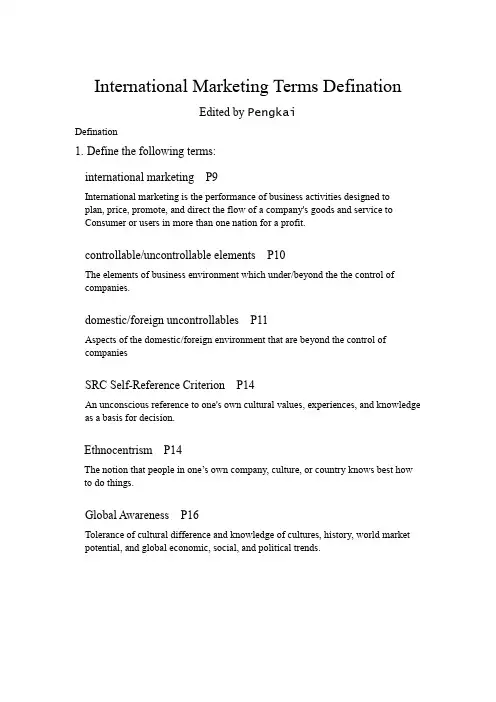
International Marketing Terms DefinationEdited by PengkaiDefination1.Define the following terms:international marketing P9International marketing is the performance of business activities designed to plan, price, promote, and direct the flow of a company's goods and service to Consumer or users in more than one nation for a profit.controllable/uncontrollable elements P10The elements of business environment which under/beyond the the control of companies.domestic/foreign uncontrollables P11Aspects of the domestic/foreign environment that are beyond the control of companiesSRC Self-Reference Criterion P14An unconscious reference to one's own cultural values, experiences, and knowledge as a basis for decision.Ethnocentrism P14The notion that people in one’s own company, culture, or country knows best how to do things.Global Awareness P16Tolerance of cultural difference and knowledge of cultures, history, world market potential, and global economic, social, and political trends.2.DefineGATT P27General Agreement on Tariffs and Trade: (1) trade shall be conducted on anon-discriminatory Basis; (2) protection shall be afforded domestic industries through customs tariffs, not through such commercial measures as import quotas;(3) consultation shall be the primary method used to solve global trade problems.WTO P28World Trade OrganizationIMF P30International Monetary Fund: Stabilize foreign exchange rates, facilitate the expansion and balance growth of international trade.EMU P36Economic and Monetary Union: A provision of the Maastricht Treaty, established the parameters of the creation of a common currency for the EU, the euro,and established a timetable for its implemention.NAFTA P39North American Free Trade Agreement: Market access, Nontariff barriers, Rules of origin,Customs administration, Investment, Service, Intellectualproperty,Government property, Government procurement, Standards.ASEAN + 3 P42Association of Southeast Asian Nations plus China, Japan, and South Korea: To deal with trade and monetary issues facing Asia.APEC P42Asia-Pacific Economic Cooperation: is a forum, far from being a free trade mon goals as to open trade, to increase economic collaboration, to sustain regional growth and development,to strengthen the multilateral trading system and to reduce barriers to investment and trade without detriment to other economics.BEMs P49big emerging markets: A small core of countries that account for more than half of the world trade growth over the next two decades, these country are identified as BEMs. See their important traits at Page 49, 50.BOPMs P48Bottom-of-the-pyramid market: A new concept introduced into the discussion of developing countries and markets. They are not defined by national borders but rather by the pockets of poverty across countries.3.Define the following terms:Manifest Destiny P62Basis of U.S. Foreign policy: Americans were a chosen people ordained by God to create a model society. More superficially, it referred to the territorial expansion of the U.S. from the Atlantic to the Pacific.Monroe Doctrine P62A cornerstone of early U.S. Foreign policy, proclaiming three basic dicta: no further European colonization in the New world, abstention of the Unite States from European political affairs, and nonintervention of European governments in the governments of the Western Hemisphere.Roosevelt Corollary P62Monroe Doctrine with an extension applied by Roosevelt: Not only would the U.S. Prohibit non-American intervention in Latin American affairs, but it would also police the area and guarantee that Latin American nations met their international obligations.Sustainable development P68A joined approach among those (governments),businesses, environmentalists, and the others) who seek economic growth with "wise resource management, equitable distribution of benefits and reduction of negative efforts on people and the environments from the process of economic grows"4.Define the following termsculture P82Culture is the human-made part of human environment----the sum total of knowledge, beliefs, art, morals, laws, customs, and any other capabilities and habits acquired by humans as members of society. or P85 is the sum of the values, rituals,symbols, beliefs, and thought processes that are learned and shared by a group of people, then transmitted from generation to generation.culture value P92A culture's values are its ideas about what is good, right, fair, and just. SeeP91—P92 how culture values influnence various types of business and market behavior comes from seminal work by Geert Hofstede.culture sensitivity P98Being attuned to the nuances of culture so that a new culture can be viewed objectively, evaluated, and appreciated.linguistic distance P95A new concept measuring the relationship between language diffence and transaction cost.social insititutions P88social institutions including family, religion, school, the media, governments,and corporations all effec the ways in which people relate to one another, organize their activities to live in harmony with one another, teache acceptable behaviour to succeeding generations, and govern themselves.cultural borrowing P99cultural borrowing is a responsible effort to learn from others’ cultural ways in the quest for better solutions to a society’s particular problems.factual knowledge P98A straightfoward fact about a culture but assumes additional significance when interpreted within the context of the culture.Interpretive knowledge P98The kind of knowledge most dependent on past experience for interpretation and most frequently prone to misintrepretetaion if one’s home country frame of reference (SRC) is used.aesthetics P95Arts, folklore, music, drama, dance, dress and cosmetics in a culture.strategy of unplanned /planned cultural change P102intoduce a productm and hope for the best / deliberately set out to change those aspects of the culture offering resistance to predetermined marketing goals. strategy of cultural congruennce P102This srtategy involces marketting products similar to noes already on the market in a manner as congruent as possible with existing cultural norms, thereby minimizing resisitance.5.Define the follwing termscultural imperatives P108Cultural imperatives are the business customs and expectations that must be met and conformed to or avoid if relationship are to be successful.cultural electives P109cultural electives relates to areas of behaviour or to customs that cultural aliens may wish to conform to or participate in but that are not required.cultural exclusives P109Cultural exclusives are those customs or behaviour patterns reserved exclusively for the locals and from which the foreigner is barred.FCPA P129Foreign Corrupt Practices ActP-time / M-time P119P-time, or polychronic time, is characterized by the simultaneous occurrence of many things and by "a great involvement with people."M-time, or monochronic time, is used on those western cultures tend to concentrate on one thing at a time.subornation P129Subornation involves giving large sum of money--frequently not properly accounted for--designed to entice an official to commit an illegal act on behalf of the one offering the bribe.the principles of Utilitarian ethics P131Does the action optimize the "common good" or benefits of all constituencies? And who are the pertinent constituencies.?the principles of Justice or fairness P131Does the action respect the canons of justice or fairness to all parties involved? silent language6.Defining the following termssovereignty P138A sovereignty state is independent and free from all external control; enjoys full legal equality with other states; governs its own territory;select its own political, economic, and social systems; and has the power to enter into agreements with other nationsNationalism P142Nationalism can be best described as an intense feeling of national pride and unity, an awakening of a nation's people to pride in their country.Confiscation, Expropriation, Domestication P144Confiscation: the seizing of a company's assets without payment Expropriation: the government seizes an investment but makes some reimbursement for the assets.Domestication: host countries gradually cause the transfer of foreign investments to national control and ownership through a series of government decrees that mandate local ownership and greater national involvement in a company's management.PSAs, NGOs P147Political and social activists (PSAs) can range from those who seek to bring about peaceful change to those who resort to violence and terrorism to effect change. Nongovernmental organizations (NGOs)7.Define the following terms:Common / code / Islamic law P159Common law, derived from English law and found in England, the United States, Canada, and other countries once under English influence;Code law, derived from Roman law and found in Germany, Japan, France, and non-Islamic and non-Marxist countries.Islamic law, derived from the interpretation of the Koran and found in Pakistan, Iran, Saudi Arabia, and other Islamic states.Marxist-socialist tenets P162Prior use versus registration P169Ownership is established by prior use in a common-law country, but it is established by registration.Conciliation P163Conciliation (also knows as mediation) is a nonbinding agreement between parties to resolve disputes by asking a third party to mediate differences.Arbitration P164The usual arbitration procedure is for the parties involved to select a disinterested and informed party or parties as referees to determine the merits of the case and make a judgement that both parties agree to honor.Litigation P166Lawsuits in public courts.Cybersquatters (CSQs) P174Cybersquatters buy and register descriptive nouns, geographic names, names of ethnic groups and pharmaceutical substances, and other similar descriptors and hold them until they can be sold at inflated price.。
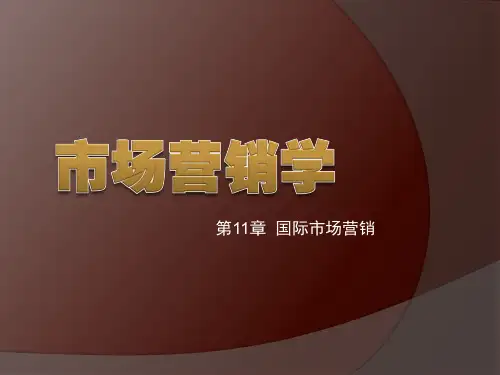
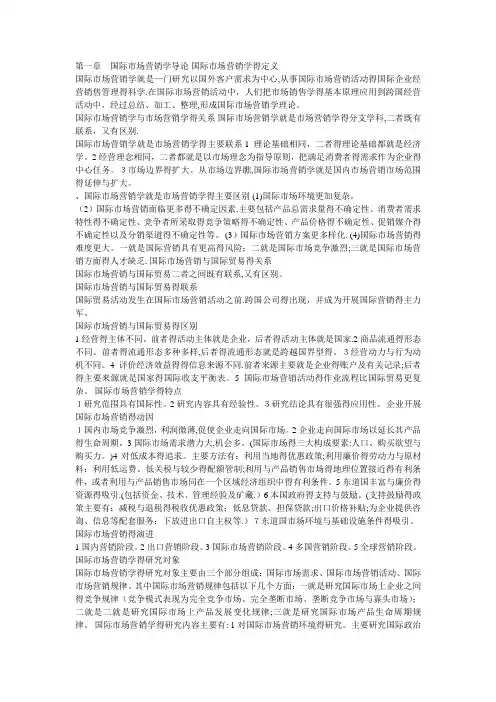
第一章国际市场营销学导论国际市场营销学得定义国际市场营销学就是一门研究以国外客户需求为中心,从事国际市场营销活动得国际企业经营销售管理得科学.在国际市场营销活动中,人们把市场销售学得基本原理应用到跨国经营活动中,经过总结、加工、整理,形成国际市场营销学理论。
国际市场营销学与市场营销学得关系国际市场营销学就是市场营销学得分支学科,二者既有联系,又有区别.国际市场营销学就是市场营销学得主要联系 1理论基础相同,二者得理论基础都就是经济学。
2经营理念相同,二者都就是以市场理念为指导原则,把满足消费者得需求作为企业得中心任务。
3市场边界得扩大。
从市场边界瞧,国际市场营销学就是国内市场营销市场范围得延伸与扩大。
、国际市场营销学就是市场营销学得主要区别 (1)国际市场环境更加复杂。
(2)国际市场营销面临更多得不确定因素.主要包括产品总需求量得不确定性、消费者需求特性得不确定性、竞争者所采取得竞争策略得不确定性、产品价格得不确定性、促销媒介得不确定性以及分销渠道得不确定性等。
(3)国际市场营销方案更多样化. (4)国际市场营销得难度更大。
一就是国际营销具有更高得风险;二就是国际市场竞争激烈;三就是国际市场营销方面得人才缺乏. 国际市场营销与国际贸易得关系国际市场营销与国际贸易二者之间既有联系,又有区别。
国际市场营销与国际贸易得联系国际贸易活动发生在国际市场营销活动之前.跨国公司得出现,并成为开展国际营销得主力军。
国际市场营销与国际贸易得区别1经营得主体不同。
前者得活动主体就是企业,后者得活动主体就是国家.2商品流通得形态不同。
前者得流通形态多种多样,后者得流通形态就是跨越国界型得。
3经营动力与行为动机不同。
4评价经济效益得得信息来源不同.前者来源主要就是企业得账户及有关记录;后者得主要来源就是国家得国际收支平衡表。
5国际市场营销活动得作业流程比国际贸易更复杂。
国际市场营销学得特点1研究范围具有国际性。
2研究内容具有经验性。
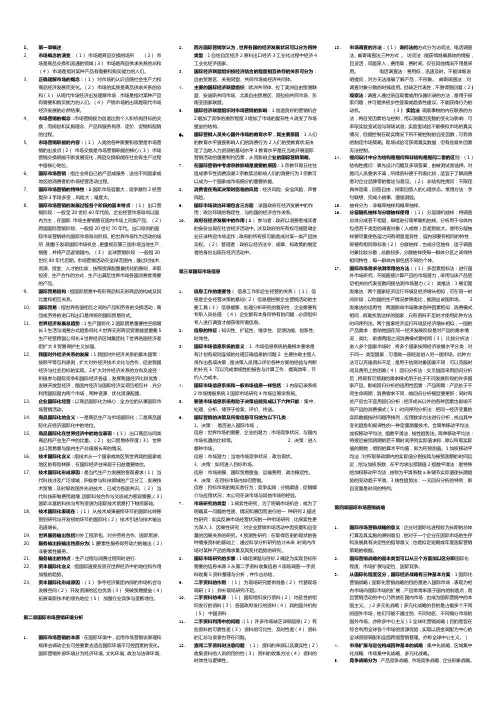
1、第一章概述2、市场概念的演变:(1)市场是商品交换的场所(2)市场是商品交换和流通的领域(3)市场是商品供求关系的总和(4)市场是指对某种产品有需要和购买能力的人们。
3、正确理解市场的概念:(1)对市场的认识应随社会生产力和商品经济发展而变化。
(2)市场的实质是商品供求关系的总和(3)从现代市场经济出发理解市场,市场是指对某种产品有需要和购买能力的人们。
(4)产销市场的出现是现代市场经济发展的必然结果。
4、市场营销的概念:市场营销视为创造达到个人和机构目标的交换,而规划和实施理念、产品和服务构思、定价、促销和配销的过程。
5、市场营销职能的内容:(1)人类的各种需要和欲望是市场营销的出发点(2)市场交换是市场营销职能的核心(3)市场营销交换职能不断发展变化,商品交换职能在社会再生产过程中居核心地位。
6、国际市场营销:指企业将自己的产品或服务,送往不同国家或地区的消费者的市场经营活动过程。
7、国际市场营销的特殊性:1国际市场容量大,竞争激烈2经营复杂3手段多变,风险大,难度大。
8、国际市场营销的发展过程各个阶段的基本特点:(1)出口营销阶段:一般至20世纪60年代前。
企业经营市场导向以国内为主,在国际市场主要销售在国内市场上同类产品。
(2)跨国国际营销阶段。
一般指20世纪70年代。
出口导向的国际市场营销转向国际市场导向阶段。
把世界市场作为活动的场所,侧重于发现国际市场机会,更重视在第三国市场当地生产、销售,并将产品返销国内。
(3)全球营销阶段:一般指20世纪80年代后期。
市场营销活动在全球范围内,通过对技术、资源、资金、人才的比较,按照资源配臵最优化的原则,采取投资、生产合作的方式,生产出满足世界市场各国消费者需要的产品。
9、国际贸易结构:指国际贸易中有形商品和无形商品的构成及其比重和相互关系。
10、国际贸易:指世界各国相互之间的产品和劳务的交换活动,商品或劳务的进口和出口是传统的国际贸易形式。
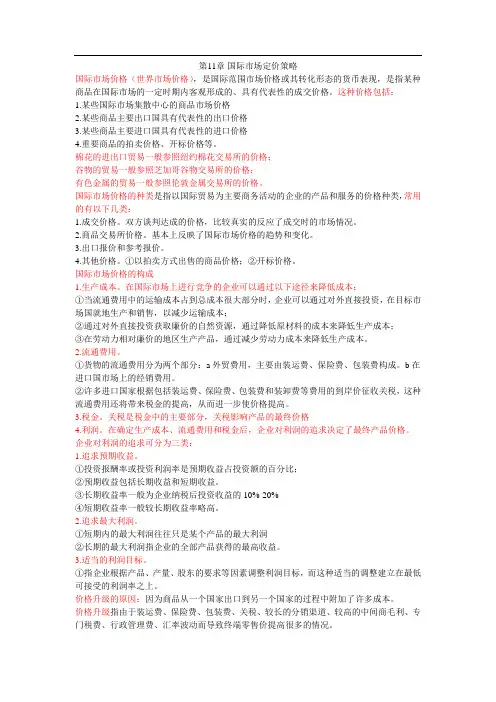
第11章国际市场定价策略国际市场价格(世界市场价格),是国际范围市场价格或其转化形态的货币表现,是指某种商品在国际市场的一定时期内客观形成的、具有代表性的成交价格。
这种价格包括:1.某些国际市场集散中心的商品市场价格2.某些商品主要出口国具有代表性的出口价格3.某些商品主要进口国具有代表性的进口价格4.重要商品的拍卖价格、开标价格等。
棉花的进出口贸易一般参照纽约棉花交易所的价格;谷物的贸易一般参照芝加哥谷物交易所的价格;有色金属的贸易一般参照伦敦金属交易所的价格。
国际市场价格的种类是指以国际贸易为主要商务活动的企业的产品和服务的价格种类,常用的有以下几类:1.成交价格。
双方谈判达成的价格,比较真实的反应了成交时的市场情况。
2.商品交易所价格。
基本上反映了国际市场价格的趋势和变化。
3.出口报价和参考报价。
4.其他价格。
①以拍卖方式出售的商品价格;②开标价格。
国际市场价格的构成1.生产成本。
在国际市场上进行竞争的企业可以通过以下途径来降低成本:①当流通费用中的运输成本占到总成本很大部分时,企业可以通过对外直接投资,在目标市场国就地生产和销售,以减少运输成本;②通过对外直接投资获取廉价的自然资源,通过降低原材料的成本来降低生产成本;③在劳动力相对廉价的地区生产产品,通过减少劳动力成本来降低生产成本。
2.流通费用。
①货物的流通费用分为两个部分:a外贸费用,主要由装运费、保险费、包装费构成。
b在进口国市场上的经销费用。
②许多进口国家根据包括装运费、保险费、包装费和装卸费等费用的到岸价征收关税,这种流通费用还将带来税金的提高,从而进一步使价格提高。
3.税金。
关税是税金中的主要部分,关税影响产品的最终价格4.利润。
在确定生产成本、流通费用和税金后,企业对利润的追求决定了最终产品价格。
企业对利润的追求可分为三类:1.追求预期收益。
①投资报酬率或投资利润率是预期收益占投资额的百分比;②预期收益包括长期收益和短期收益。
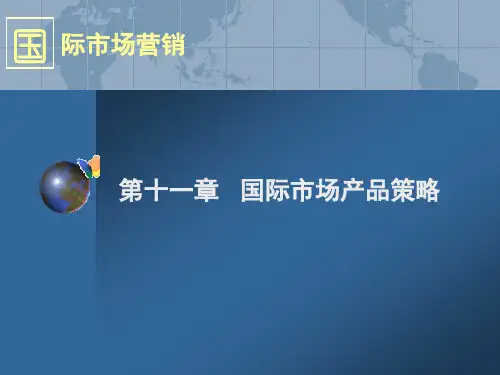
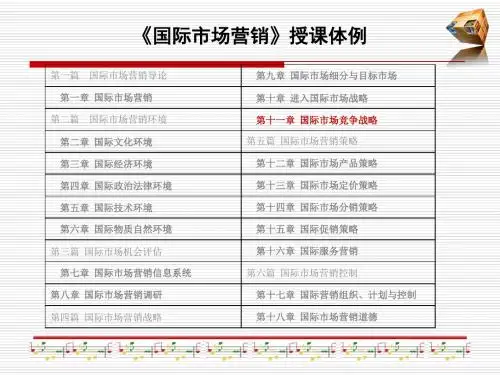
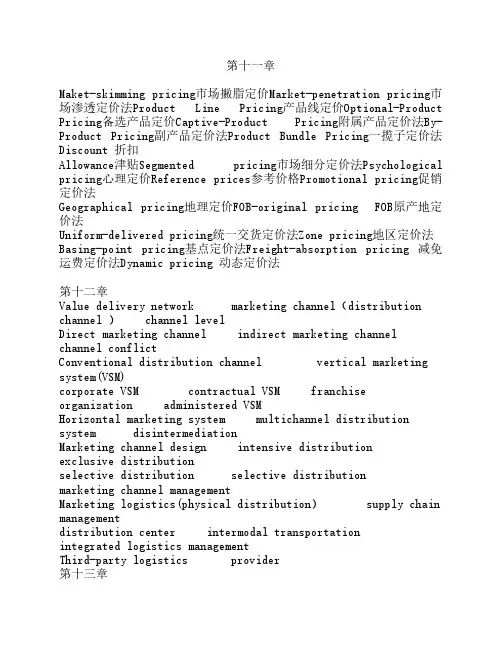
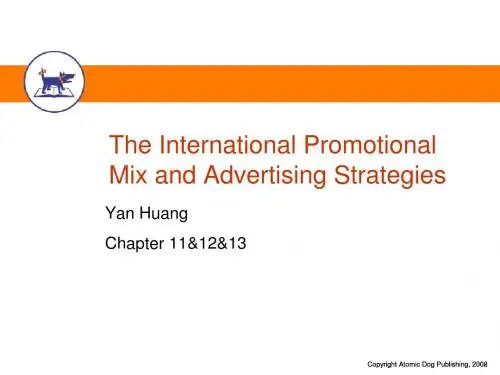

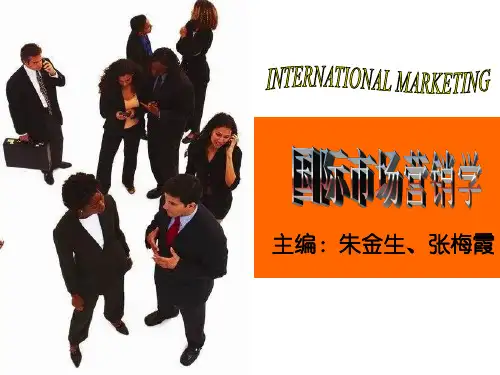
国际市场营销学市场营销是现代商业活动的核心,而国际市场营销则进一步拓展了企业的发展空间和机会。
国际市场营销学作为一门学科,研究的是企业如何在全球范围内进行市场推广和销售,以实现跨国经营的目标。
本文将从国际市场营销的概念与特点、战略与策略、实施与管理等方面进行探讨。
一、国际市场营销的概念与特点国际市场营销,顾名思义,是企业在全球范围内开展市场推广和销售的活动。
与传统的市场营销相比,国际市场营销具有以下几个明确的特点:1. 具有跨国性:国际市场营销的范围超越了国家和地域的界限,企业需要考虑不同国家和地区的文化、法律、经济环境等因素。
2. 面对多样化的市场需求:不同国家和地区的市场需求各有特点,国际市场营销需要根据当地的文化、消费习惯等因素来制定相应的营销策略。
3. 需要适应不同的竞争环境:国际市场竞争激烈,企业需要应对来自全球范围内的竞争对手,寻找差异化的竞争优势。
二、国际市场营销的战略与策略国际市场营销需要制定相应的战略与策略,以便在全球范围内取得竞争优势。
1. 国际市场定位:企业需要明确自己所面对的市场定位,在全球范围内寻找适合自己产品或服务的市场细分。
2. 品牌建设:通过品牌建设,企业能够形成国际市场上的知名度和信誉度,提高产品或服务的竞争力。
3. 产品适应性:不同国家和地区的消费者需求不同,企业需要进行产品的适应性调整,以满足当地市场的需求。
4. 价格策略:在制定价格策略时,企业需要考虑到不同国家和地区的经济环境、消费水平等因素,采取差异化的定价方式。
5. 渠道管理:国际市场营销需要建立有效的渠道网络,包括选择合适的分销商、建立海外分支机构等。
三、国际市场营销的实施与管理国际市场营销的实施与管理是确保市场活动顺利进行的关键。
1. 国际市场研究:在进入国际市场前,企业需要进行详尽的市场研究,了解目标市场的特点、竞争对手的情况等。
2. 人力资源管理:国际市场营销需要招募和培养具有跨文化背景和语言能力的人才,以满足不同市场的需求。